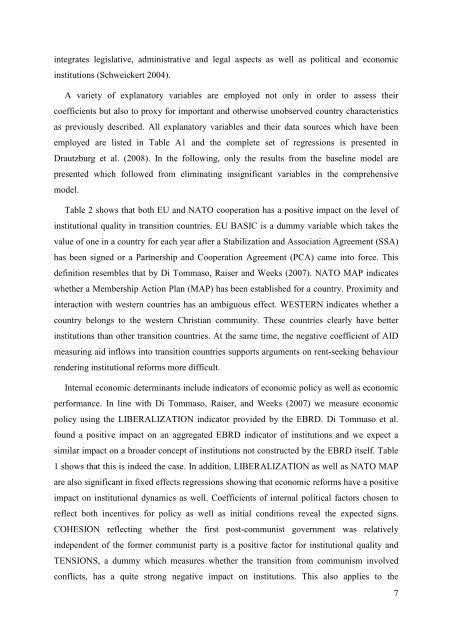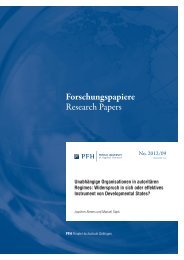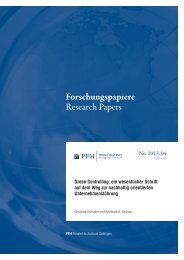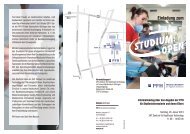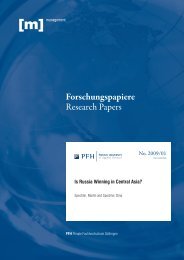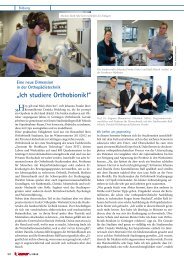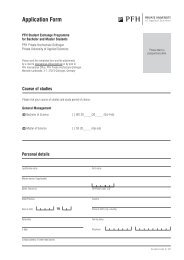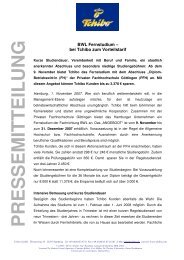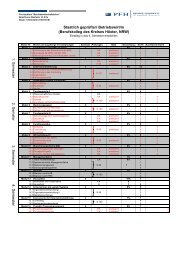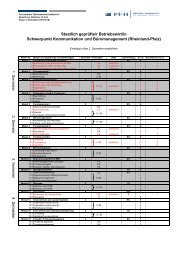View - PFH Private Hochschule Göttingen
View - PFH Private Hochschule Göttingen
View - PFH Private Hochschule Göttingen
Create successful ePaper yourself
Turn your PDF publications into a flip-book with our unique Google optimized e-Paper software.
integrates legislative, administrative and legal aspects as well as political and economic<br />
institutions (Schweickert 2004).<br />
A variety of explanatory variables are employed not only in order to assess their<br />
coefficients but also to proxy for important and otherwise unobserved country characteristics<br />
as previously described. All explanatory variables and their data sources which have been<br />
employed are listed in Table A1 and the complete set of regressions is presented in<br />
Drautzburg et al. (2008). In the following, only the results from the baseline model are<br />
presented which followed from eliminating insignificant variables in the comprehensive<br />
model.<br />
Table 2 shows that both EU and NATO cooperation has a positive impact on the level of<br />
institutional quality in transition countries. EU BASIC is a dummy variable which takes the<br />
value of one in a country for each year after a Stabilization and Association Agreement (SSA)<br />
has been signed or a Partnership and Cooperation Agreement (PCA) came into force. This<br />
definition resembles that by Di Tommaso, Raiser and Weeks (2007). NATO MAP indicates<br />
whether a Membership Action Plan (MAP) has been established for a country. Proximity and<br />
interaction with western countries has an ambiguous effect. WESTERN indicates whether a<br />
country belongs to the western Christian community. These countries clearly have better<br />
institutions than other transition countries. At the same time, the negative coefficient of AID<br />
measuring aid inflows into transition countries supports arguments on rent-seeking behaviour<br />
rendering institutional reforms more difficult.<br />
Internal economic determinants include indicators of economic policy as well as economic<br />
performance. In line with Di Tommaso, Raiser, and Weeks (2007) we measure economic<br />
policy using the LIBERALIZATION indicator provided by the EBRD. Di Tommaso et al.<br />
found a positive impact on an aggregated EBRD indicator of institutions and we expect a<br />
similar impact on a broader concept of institutions not constructed by the EBRD itself. Table<br />
1 shows that this is indeed the case. In addition, LIBERALIZATION as well as NATO MAP<br />
are also significant in fixed effects regressions showing that economic reforms have a positive<br />
impact on institutional dynamics as well. Coefficients of internal political factors chosen to<br />
reflect both incentives for policy as well as initial conditions reveal the expected signs.<br />
COHESION reflecting whether the first post-communist government was relatively<br />
independent of the former communist party is a positive factor for institutional quality and<br />
TENSIONS, a dummy which measures whether the transition from communism involved<br />
conflicts, has a quite strong negative impact on institutions. This also applies to the<br />
7


